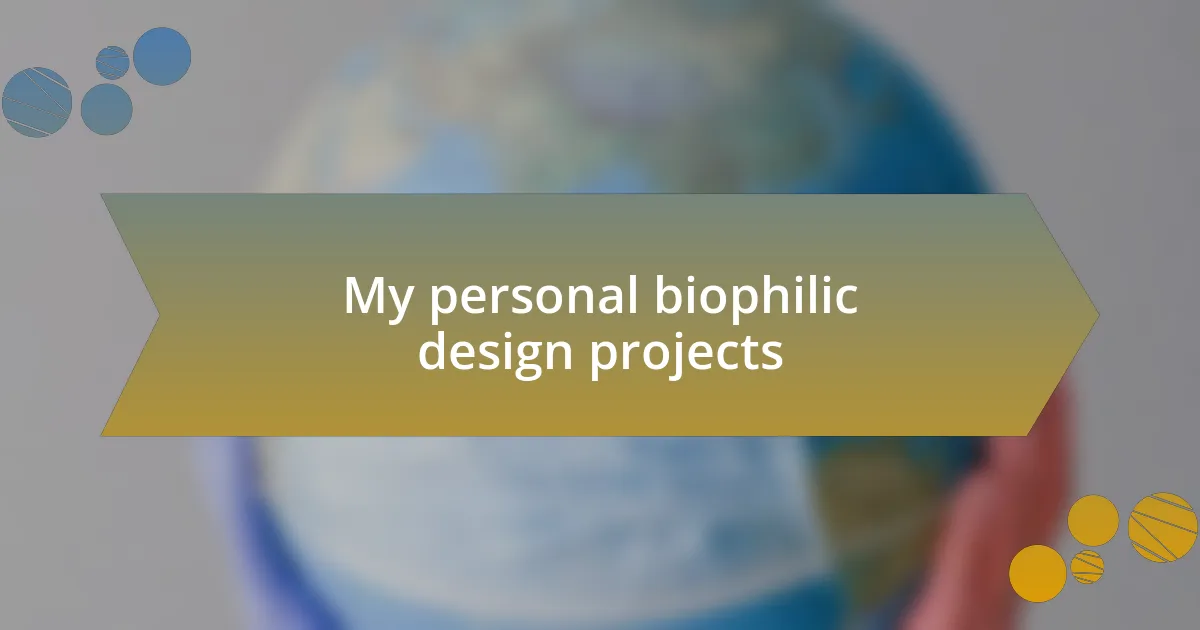Key takeaways:
- Biophilic design enhances well-being by integrating natural elements, such as light, materials, and views, into indoor spaces.
- Simple techniques like incorporating plants, natural sounds, and earth-toned color palettes can significantly improve indoor environments.
- Personal biophilic projects can foster joy and a deeper connection to nature, making spaces more inviting and serene.
- Challenges in implementing biophilic design include logistical constraints and balancing modern aesthetics with natural elements.

Understanding biophilic design principles
Biophilic design principles center around the intrinsic human connection to nature, emphasizing natural elements in our surroundings. I often think back to a hiking adventure where the visceral experience of being enveloped by trees and the sound of a nearby stream brought an invigorating sense of calm—this is the essence of biophilic design.
Consider the aesthetic appeal of incorporating natural light or indoor plants; these elements not only beautify a space but can significantly enhance our mood and productivity. In my experience, adding greenery to my workspace created a lively atmosphere that fosters creativity, reminding me daily of the outdoors. Have you ever noticed how a simple potted plant can transform your environment?
Furthermore, biophilic design isn’t just about aesthetics; it’s about functionality, promoting well-being through mindful connections with nature. Whenever I sit by a window that frames a beautiful view, I’m reminded of how even a small change can make a significant difference in my overall health and happiness. By weaving nature into our spaces, we not only create harmony but also offer ourselves a tangible respite from the fast-paced world around us.

Key elements of biophilic design
Key elements of biophilic design
One of the most significant elements of biophilic design is the integration of natural light. I remember working in an office with huge windows that flooded the space with sunlight; it was mesmerizing. The uplifting effect that natural light had on my energy levels was obvious. Can you picture how different a dimly lit room feels compared to one bathed in warm, natural light?
Another core component is incorporating natural materials. I’ve always felt a strong connection to wood and stone—these elements ground me. For instance, when I replaced synthetic furniture with reclaimed wood pieces in my living room, it felt as though I had invited a piece of the outdoors inside, creating a cozy and inviting atmosphere. Don’t you agree that authentic materials add a sense of history and warmth to our environments?
Lastly, connection to nature can be facilitated through views and landscapes. I’ve spent countless hours enjoying my backyard garden, finding solace in the colors and textures of the blooms. The mere sight of nature outside my window always gives me a sense of peace. Have you ever noticed how a beautiful view can shift your mood in an instant? By creating spaces that frame these natural scenes, we establish a healthier interaction with our surroundings.

Techniques for integrating nature indoors
Integrating plants is one of the most straightforward techniques I’ve discovered for bringing nature indoors. Recently, I transformed a small corner of my kitchen into a mini-garden with herbs and some potted plants. The fresh scents and vibrant greenery not only liven up the space but also invite a sense of calm and connection to nature. Have you ever walked into a room filled with lush plants and felt your stress melt away?
Incorporating natural sounds can also elevate indoor spaces. I invested in a small water fountain for my study, which creates a gentle background hum of flowing water. It’s surprising how this simple addition can evoke the tranquility of a forest stream. Think about the last time you heard rain tapping on your window or leaves rustling in the wind; didn’t it instantly make you feel more grounded?
Using biophilic color palettes is another effective method. I painted my living room with soft earth tones inspired by nature—think muted greens and warm tans. These colors evoke feelings of serenity and connection to the outdoors. Have you ever noticed how certain colors can influence your mood? When the walls reflect the essence of nature, it’s like an embrace from the environment itself.

My personal biophilic design projects
One of my favorite biophilic design projects was creating an indoor botanical wall in my living room. I used a variety of climbing plants, allowing them to snake up a trellis I built from reclaimed wood. Watching them thrive and knowing I brought a piece of the outdoors inside fills me with such joy. Have you ever felt the thrill of nurturing something green and watching it flourish?
Another project that stands out is my attempt to capture natural light in innovative ways. I installed mirrors in strategic locations to reflect sunlight throughout my home, effectively brightening dark corners. When I step into a room bathed in natural light, it feels as though I’m stepping into a sunlit forest clearing. Isn’t it incredible how light can change the atmosphere in a space?
Lastly, I’ve experimented with natural textures in my work area—incorporating wood and stone elements to create a tactile experience reminiscent of being outdoors. For example, my desk is made from reclaimed barn wood, which gives me a sense of grounding as I work. Have you noticed how certain materials can enhance your connection to the environment? Each element I incorporate seems to pull me closer to nature, making my workspace much more enjoyable.

Challenges in implementing biophilic design
Implementing biophilic design certainly has its hurdles. For instance, I recall a project where I wanted to bring a lush vertical garden into a small office space. It was thrilling to imagine, but I quickly discovered that the necessary conditions—like adequate light and humidity—were challenging to maintain. Have you ever embarked on a vision only to face unexpected barriers?
Another challenge I encountered was integrating biophilic elements without overwhelming the existing aesthetic. I attempted to add natural materials to a contemporary-designed space and found the balance tricky. It required thoughtful placement and selection, prompting me to ask myself, how can I merge the modern with the organic in a way that feels seamless?
Budget constraints can also limit the scope of biophilic design. During one renovation, I dreamed of using premium sustainable materials but had to settle for less expensive options. This experience taught me that while passion fuels creativity, practicality must steer the project—how do we find the sweet spot between idealism and reality in our designs?